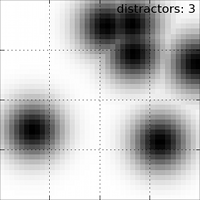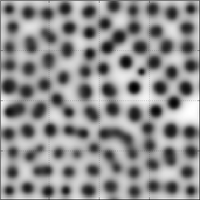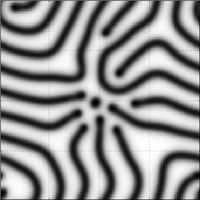
Here are some examples of the kind of computation you can achieve using the DANA framework. Be sure to have also a look at the examples directory as well as the models one to get other examples of what can be done with DANA.
The dynamical neural field (DNF) theory has been introduced by Wilson and Cowan, and latter formalised by Amari and Taylor. This theory considers a neural population at the tissue level governed by a unique differential equation that describe the spatio-temporal evolution of coarse grained variables such as synaptic or firing rate activity. There have been numerous theoretical works related to the study of DNF properties like pattern formation, analytical solution, bifurcation conditions, etc.



More formaly, DNF equation reads:
1/α ∂u(x,t)/∂t = -u(x,t) + ∫ w(║y-x║) f(u(y,t))dy + I(x,t) (1)
where:
It is thus straightforward to numerically integrate the equation considering a given spatial and temporal resolution.
n = 256
src = np.zeros((n,))
tgt = Group((n,), """ dU/dt = (-V + 0.1*L + I);
V = maximum(U,0);
I; L """)
SparseConnection(src, tgt('I'), np.ones((1,)))
SharedConnection(tgt('V'), tgt('L'), +1.10*gaussian(2*n+1, 0.20)
-0.95*gaussian(2*n+1, 1.00))
The Gray Scott model is a mathematical model of the reaction and diffusion of chemical species and may produce a variety of behaviors as illustrated below:



A Gray Scott model is described by a set of two differential equations:
that can be very easily modeled using DANA:
Z = Group((n,n), """ du/dt = Du*Lu - Z + F*(1-U)
dv/dt = Dv*Lv + Z - (F+k)*V
U = np.maximum(u,0)
V = np.maximum(v,0)
Z = U*V*V
Lu; Lv; """)
K = np.array([[np.NaN, 1., np.NaN],
[ 1., -4., 1. ],
[np.NaN, 1., np.NaN]])
SparseConnection(Z('U'),Z('Lu'), K, toric=True)
SparseConnection(Z('V'),Z('Lv'), K, toric=True)
The full sources for screenshots above are available from the models directory in the DANA distribution.
The Bellmann-Ford algorithm can be implemented using DANA as illustrated below:

The idea is simply to use DANA to diffuse a value and to climb back the V value to get the shortest path.
n = 61
a = 0.99
Z = 1-maze((n,2*n+1))
G = Group((n,2*n+1),'''V = I*maximum(maximum(maximum(maximum(V,E),W),N),S)
W; E; N; S; I''')
SparseConnection(Z, G('I'), np.array([ [1] ]))
SparseConnection(G('V'), G('N'), np.array([ [a], [np.NaN], [np.NaN] ]))
SparseConnection(G('V'), G('S'), np.array([ [np.NaN], [np.NaN], [a] ]))
SparseConnection(G('V'), G('E'), np.array([ [np.NaN, np.NaN, a] ]))
SparseConnection(G('V'), G('W'), np.array([ [a, np.NaN, np.NaN] ]))